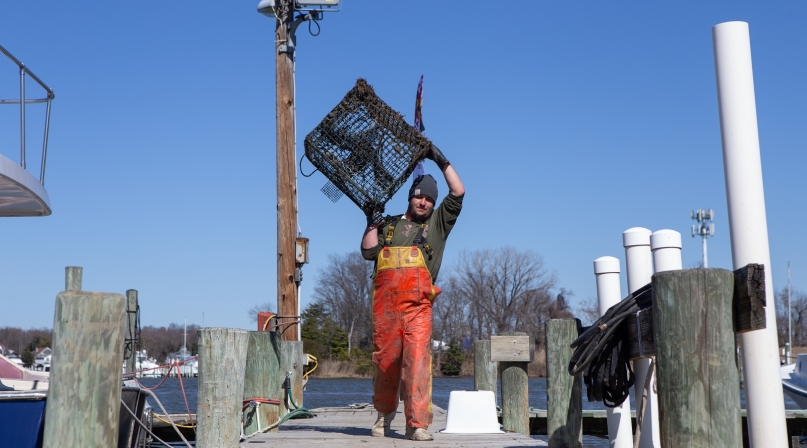Baltimore County bay cleanup aids the local ecosystem and crabbing industry

Key Takeaways
It was the problem that flew under the radar. Or to be more accurate, plummeted below the sonar.
Propellors pushing boats throughout the Chesapeake Bay were inadvertently severing the ropes that connected buoys to hundreds of traps that fed Maryland’s appetite for blue crabs. With the cages no longer tethered to something keeping them close to the surface, they sunk to the bottom of the bay, still serving as an obstacle for crabs but keeping them from the watermen and waterwomen who brought them to market.
For the last two years, Baltimore County has been supporting an annual removal of derelict crab pots, removing a hazard to aquatic life and helping support a vital part of the county’s economy and character.
“It’s a form of competition with fisheries,” said Ward Slacum, executive director of the Oyster Recovery Partnership. “Crabs and other life are getting caught in these viable traps, but nobody is bringing them to the surface. They’re eventually dying down there and never taken to market.”
There’s a lot of collateral damage in addition to crabs, according to Baltimore County natural resource specialist Dave Riter: White perch, eels, Black Sea bass and more.
The more animals that die in the “ghost traps,” the more they attract other fish and become bait. Slacum estimates roughly 10 percent of crab traps are lost because of severed tether lines, particularly as recreational boating increases in heavily crabbed waters. Those ghost traps can claim millions of crabs per year.
Based on community feedback, County Executive John Olszewski, Jr. directed the county’s Department of Environmental Protection and Sustainability to help fund cleanup efforts led by the Oyster Recovery Partnership. For two weeks each spring, local watermen recruited by the partnership have trawled the bay with grappling hooks, recovering hundreds of pots that could be as large as 3 feet by 3 feet by 3 feet.
“By periodically removing these crab traps, there’s an immediate impact on the fisheries population and, one could argue, an economic benefit too,” he said.
In 2022, a $125,000 allocation funded the removal of 2,051 out of a possible 3,625 objects identified by sonar scans over a 2,000-acre area off of North Point State Park. In 2023, 1,262 out of 2,116 pots in a 3,000-acre area off of Hart Miller Island came off the bay floor. Each operation put a major dent in what had accumulated over decades, and some of the materials are recycled.
“It has a quick return,” Riter said. “A lot of things we do in my office take years to design and build. It takes two, three, four years to get my projects in the ground and then do they have an immediate benefit? Not like this.”
“We’re very excited that Baltimore County sees the value in it to pursue it as a project,” Slacum said. “It’s about sustainable fishing practices, it’s about that investment in our region. We want these fishermen to make a living, we want to help them define better ways to fish more sustainable practices removing those traps. I think that that’s a sustainable practice.
“It’s a win-win because they are using their knowledge of the area to do a good job clearing it, and they are being paid to ultimately make the bay more productive for the industry and cut waste.”
Attachments
Related News

White House signs executive orders to boost coal industry
On April 8, President Trump signed four [RY1] [CM2] executive orders (EOs) focused on the U.S. coal industry, aligning with the Administration’s “Unleashing American Energy” EO signed in January 2025.

County Countdown – April 7, 2025
Every other week, NACo's County Countdown reviews top federal policy advocacy items with an eye towards counties and the intergovernmental partnership. This week features a budget reconciliation update, HHS restructuring and more.
